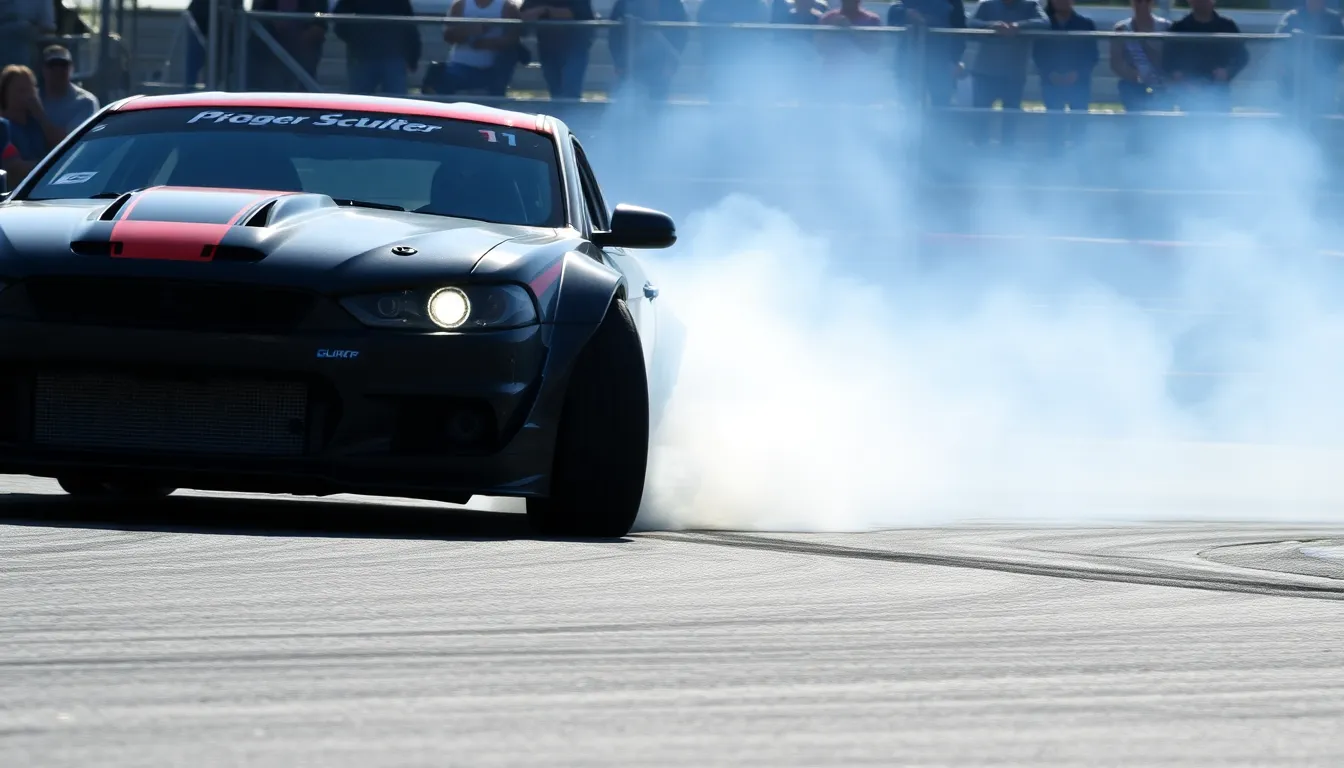In the high-octane world of drifting, scoring systems are the unsung heroes that keep the competition alive and kicking. Imagine a thrilling showdown where drivers showcase their skills, but instead of just cheering, there’s a system in place that assigns points like a judge at a talent show. Drift scoring systems not only add structure to the chaos but also elevate the excitement, ensuring every tire squeal and smoky turn gets the recognition it deserves.
Overview of Drift Scoring Systems
Drift scoring systems evaluate drivers through a series of criteria, bringing clarity and fairness to competitions. These systems assess various elements such as speed, angle, line, and overall execution. Evaluators, often judges or experts in the field, assign points based on the driver’s performance in each category.
Performance in drifting primarily focuses on the aesthetics of a drift. Judges award higher scores for smooth transitions and precise line usage. Drivers can earn additional points for maintaining high speed during maneuvers. Each competition may involve a different weighting of these criteria, creating unique scoring dynamics.
A typical scoring structure may include a range from 0 to 100 points, with each judge scoring separately. These scores combine to form an overall ranking for each driver. When multiple judges assess performances, this approach enhances the accuracy and fairness of the results.
Additionally, drift scoring systems adapt to the evolving nature of the sport. New technologies, such as telemetry data, may influence scoring processes in the future. Such advancements may lead to more precise measurements of speed and angle.
In essence, drift scoring systems contribute significantly to the structure of drifting competitions. By ensuring that skill and performance get recognized, they elevate the experience for drivers and spectators alike.
Types of Drift Scoring Systems

Drift scoring systems come in various formats, each offering unique advantages for evaluating driver performance. Two notable types are continuous drift scoring and discrete drift scoring.
Continuous Drift Scoring
Continuous drift scoring evaluates driver performance throughout the entire run. Points accumulate based on specific criteria, maintaining a fluid assessment of skill. Judges assess factors such as speed, angle, and line consistently during the drift. This method enhances fairness, allowing for real-time evaluation and adjustment of scores as drivers execute their maneuvers. Continuous scoring fosters a dynamic atmosphere, where drivers remain aware of the impact of their performance on the overall score.
Discrete Drift Scoring
Discrete drift scoring, in contrast, assigns scores in segmented intervals or categories. Points are awarded based on specific criteria at predetermined checkpoints rather than throughout the entire run. Each segment focuses on particular skills, such as initiation or transition, allowing judges to concentrate on distinct aspects of the drift. This structured approach simplifies scoring, providing clear criteria for both judges and participants. Discrete scoring can lead to more straightforward comparisons among drivers, as scores reflect performance at specific moments rather than a cumulative total.
Applications of Drift Scoring Systems
Drift scoring systems find their way into various sectors, showcasing their versatility beyond motorsports.
Financial Sector
In the financial sector, drift scoring can enhance decision-making processes. Institutions utilize drift scoring to assess the performance of trading algorithms, evaluating how consistently they execute trades against market trends. Accurate assessments lead to optimized strategies and better risk management. Furthermore, scoring can apply to the evaluation of financial products, where customer satisfaction and performance metrics determine effectiveness. Focusing on metrics such as return on investment and volatility, financial analysts accelerate the identification of successful investment trajectories and improve overall portfolio management.
Healthcare Industry
The healthcare industry also benefits from drift scoring systems. These systems can evaluate hospital performance across various services, ensuring patient care standards remain high. Measuring key performance indicators such as treatment times and patient outcomes allows healthcare providers to identify areas needing improvement. In addition, drift scoring facilitates the assessment of new medical technologies, where consistent results mark effectiveness. Staff performance is another critical area where scoring can drive improvement; healthcare facilities can streamline operations and enhance patient experiences by analyzing the efficiency of healthcare practitioners.
Advantages of Implementing Drift Scoring Systems
Drift scoring systems enhance competition by providing a structured evaluation framework, fostering excitement among participants. Clarity stems from detailed criteria, allowing drivers to understand how their skills translate to scores. Fairness is achieved through multiple judges, as diverse evaluations reduce individual bias and contribute to more accurate rankings.
Judges assess speed, angle, and execution, ensuring that every performance aspect is considered. By emphasizing aesthetics, these systems incentivize drivers to refine their techniques for a better show. Efficiency improves, as real-time scoring adjustments can reflect performance nuances, maintaining engagement throughout events.
Superior versatility defines drift scoring systems beyond motorsports. In finance, these systems evaluate trading strategies based on metrics like return on investment. Hospitals use them to assess patient care by analyzing key performance indicators, driving quality improvements. When applied across various sectors, drift scoring promotes effective resource allocation and operational excellence.
In drifting competitions, a typical scoring range from 0 to 100 allows for clear differentiation between driver performances. Spectators gain a richer understanding of the sport as they witness the real-time impact of executed techniques on scores. Engagement increases, drawing spectators closer to the action and amplifying their investment in the competition.
Overall, implementing drift scoring systems cultivates an atmosphere of competition that celebrates skill and improvement. Clarity, fairness, and adaptability contribute to an elevated experience for both drivers and audiences alike.
Challenges and Limitations
Drift scoring systems face several challenges that may impact their effectiveness. Subjectivity in scoring often arises as judges interpret criteria differently, leading to inconsistencies in point allocation. Variations in judges’ backgrounds, preferences, and experiences can also contribute to this issue, which complicates the fairness of competitions.
Additionally, the evolving nature of drifting can make traditional scoring methods less relevant. As new techniques emerge, existing criteria might not adequately capture the complexity of advanced maneuvers. This gap in scoring relevance can lead to inadequate assessments of driver performance, ultimately affecting rankings.
Technical limitations in some scoring systems present further challenges. Continuous scoring relies on real-time assessments, but issues with data transmission can create inconsistencies. Technology glitches may result in lost connections or inaccurate data, undermining the credibility of the scoring process.
Moreover, the reliance on aesthetics in scoring raises concerns over the prioritization of style over substance. Judges may favor visually impressive maneuvers, but this approach can overshadow essential skills like precision and speed. The disproportionate focus on aesthetics might skew competition results, potentially frustrating drivers who excel in technical execution.
Budget constraints also limit the implementation of advanced scoring technologies. Many organizations may struggle to afford the latest systems, making it difficult to keep up with industry trends. These financial limitations restrict the opportunities for refining scoring processes and adopting innovative solutions.
Ultimately, drift scoring systems strive for fairness and clarity. Balancing subjectivity, emerging techniques, technical limitations, aesthetic biases, and budget constraints proves essential for maintaining the integrity of drifting competitions. Addressing these challenges ensures continued growth and enhances the competitive landscape of the sport.
Drift scoring systems are essential for the evolution of drifting as a competitive sport. They not only enhance the excitement of events but also promote fairness and clarity in judging. By evaluating key performance metrics and embracing new technologies, these systems can adapt to the sport’s changing landscape.
While challenges like subjectivity and technical limitations exist, the benefits of structured scoring are undeniable. They encourage drivers to hone their skills and engage audiences more effectively. As drift scoring systems continue to develop, they’ll play a pivotal role in shaping the future of drifting and its applications across various industries. The commitment to improving these systems will ensure that the sport remains dynamic and accessible for both competitors and fans.





